Description
Caribbean Red Snappers are called “snapper” because of their large, animal-like teeth. Red Snappers have trademark red skin and red eyes and come from waters off the Southeast Atlantic and Gulf states and Mexico.
They have a single dorsal fin with 10 spines and 14, rarely 13 or 15, soft rays, spinous portion of fin not deeply incised at its connection with soft portion. Anal fin with 3 spines and 9, sometimes 8, soft rays, angulated in specimens more than about 5 cm standard length. Last soft ray of both dorsal and anal fins is not extended. Their caudal fin truncate to lunate, pectoral fin has 15 to 18, usually 17, rays. Membranes of soft dorsal and anal fins have scales. There are 46 to 51, usually 47 or 48 tubed scales in lateral line. There are 7 to 10 scales above lateral line and 15 to 19 scales below lateral line. Maxilla does not have any scales. There are 21 to 24 gill rakers including 6 to 8 on first arch on upper limb and 14 to 16 on lower limb.
Red snapper average 24 inches in length, with a maximum size of 39 inches and up to 20 lbs. Estimated maximum age is 40-50 years. Growth is approximately 4 inches per year for the first 6 years, after which the growth rate generally declines.
Gillneting is illegal for Red Snapper so most of them are caught by longline, and sometimes by trawls and traps.
The Red Snapper is also known in Brazil as Cioba/Pargo vermelho.
Where can the Red Snapper be found?
The Red Snapper, a deep-water fish, commonly inhabits waters from 30 to 200 ft, but can be caught as deep as 300 ft or more on occasion with the temperature range from 50 to 70 F. They stay relatively close to the bottom, and inhabit rocky bottom, ledges, ridges, and artificial reefs, including offshore oil rigs and shipwrecks. Juveniles inhabit shallow waters, most abundantly over sand or mud bottoms. Adults inhabit rocky areas. They feed mainly on fishes, shrimps, crabs, cephalopods and planktonic items.
How do Red Snappers look like?
Red Snappers can grow to about 35 pounds, but average market size is 4 to 6 pounds. Red Snapper under 4 pounds have pink, metallic colored skin. Older fish have red skin and red eyes.
The Red snapper have a sloped profile, medium-to-large scales, a spiny dorsal fin and a laterally compressed body. They have short, sharp, needle-like teeth. Both jaws have villiform teeth, but the lower jaws are slightly larger. The upper jaw also has several canine teeth. The lower jaw protrudes slightly beyond the upper. Their prominent upper canine teeth are like found on the mutton, dog, and mangrove snappers. There are no teeth on ectopterygoids. The depth of its body is a little more than a 1/3rd of its length, being rather deep and compressed, the back elevated and regularly arched from the eye to the tail. The head is large, its length equal to the depth of the body, with a pointed snout, large mouth, and straight profile. They have long triangular snout; anal fin sharply pointed; no dark lateral spot.
Their entire body and fins are pinkish red in color, with more intense pigment on the back, lightening to a rosy white underside. The vibrant red color of these fish comes from high levels of carotenoid pigments, largely astaxanthin, coming from shrimp in their natural diet. The color is paler on the throat; fins all red, the vertical fins bordered with dusky blue; there is a dark blotch under the front of the soft portion of the dorsal fin (persisting to about 25 to 30 cm standard length), except in the oldest and largest fish; the iris of the eye is scarlet. The caudal fin has dark distal border. Juvenile fish can also have a dark spot on their side which fades with age. At a size less than 14 inches red snappers exhibit a dark spot on the upper sides below the anterior soft dorsal rays. Juveniles sometimes display bluish stripes on their sides.
How do Red Snappers behave?
The red snapper is a bottom fish, feeding in company with the large groupers on small fishes, crustaceans, cephalopods, miscellaneous benthic invertebrates, and planktonic organisms. It grows to 20 or 30 lbs, but its common size is from 5 to 10 lbs. Adult red snapper live offshore on the continental shelf, over deep reefs, banks, and rock bottoms. Older, larger fish tend to prefer the cooler, deeper spots. Young red snapper live in muddy and sandy bottoms. As juveniles mature they seek out cover in the form of ledges, rock outcroppings, and wrecks. During winter they move offshore to avoid the cooler, shallow inshore waters.
Fresh Red Snapper: Health benefits
Red snapper is a low-calorie, lean source of protein that is rich in selenium, vitamin A, potassium and omega-3 fatty acids. A diet that regularly incorporates these nutrients may significantly benefit your health by preventing serious medical conditions. Despite the potential health benefits, red snapper may contain mercury levels that make it unsafe for pregnant women and young children to eat more than a few times a month. However, if it’s safe for you to eat in moderation, it can provide nutrients.
Selenium: A single, 3.5-ounce serving of red snapper contains nearly 70 percent of the amount of selenium that the U.S. Department of Agriculture recommends daily for adult men and women following a 2,000-calorie diet. Selenium supports white blood cell function and is required for the thyroid gland to work properly. It is an antioxidant that may be able to prevent free radical compounds from causing the DNA damage that can lead to rheumatoid arthritis, cancer and heart disease. Selenium’s antioxidant power is enhanced when it is combined with a source of vitamin E. Serve selenium-rich fish like red snapper with high-vitamin E foods like asparagus, sweet potatoes or dark, leafy greens like spinach, beet greens or kale.
Vitamin A: Each serving of cooked red snapper provides 14 percent of the RDA of vitamin A for an adult woman and 11 percent of the RDA of vitamin A for a man. Vital for the immune system, the production and maintenance of bones and the health of the skin and eyes, vitamin A also plays a role in cell reproduction and differentiation. Eating adequate amounts of vitamin A daily may decrease your risk of developing eye disorders like cataracts or age-related macular degeneration. Vitamin A is a fat-soluble nutrient and requires a source of dietary fat to be absorbed by the intestines. Serve red snapper drizzled with olive oil or topped with a salsa containing lipid-rich avocados.
Potassium: Red snapper contains 444 milligrams, or 9 percent of the RDA, of potassium in each cooked serving. Potassium is both a mineral and an electrolyte. It is required by the body to trigger enzymes needed in energy metabolism and to allow smooth, cardiac and skeletal muscles to contract properly. A diet that lacks adequate potassium levels may increase your chance of stroke, high blood pressure, osteoporosis and kidney stones. You may become deficient in potassium if you regularly consume a large amount of sodium. Consult your doctor about ways to decrease your sodium intake and increase your potassium levels safely.
Omega-3 Fatty Acids: Red snapper contains 0.31 grams of omega-3 fatty acids in each 100-gram serving. This concentration of omega-3 fatty acids is roughly equal to the amount provided by a 3-ounce serving of shrimp, catfish, crabs or scallops. The American Heart Association reports that eating fish rich in omega-3 fatty acids regularly may significantly decrease your risk of heart disease, atherosclerosis and high blood cholesterol. The AHA recommends that adults and non-pregnant women should eat 3.5 ounces of a variety of grilled or baked fish twice weekly. Pregnant women and children should avoid eating red snapper more than a few times a month to prevent mercury contamination.
Fresh Red Snapper: Culinary profile
Red Snapper is a lean, moist fish with a firm texture and a distinctive sweet, nutty flavor wich makes it versatile for many flavor components from mild to intense seasoning. Many other fish are marketed as “Red Snapper” but are not the real thing so check your sources, and buy it with the skin on so you can verify the skin color.
The raw flesh of Red Snapper is pinkish with yellow streaks, turning lighter (but not white) when cooked. The skin is deep red along the back which fades to a lighter pinkish-red on the on the belly.
Fresh Red Snapper Videos
Fresh Red Snapper Artiless
Fresh Red Snapepr: Nutritional facts
- Serving size: 5 oz (raw)
- Calories: 218 kcal
- Calories from fat: 26 kcal
- Total fat: 2.9 grams
- Saturated Fat, total: 0.06 grams
- Cholesterol: 80 mg
- Sodium: 97 mg
- Potassium: 887 mg
- Carbohydrate: 0 g
- Sugars, total: 0 g
- Protein: 47 grams
- Fiber, total: 0 g
- Vitamin A: 3.9% *PDV
- Vitamin C: 4.5% *PDV
- Calcium: 5.2% *PDV
- Iron: 2.3% *PDV
* Percent Daily Values are based on a 2000 calorie diet.
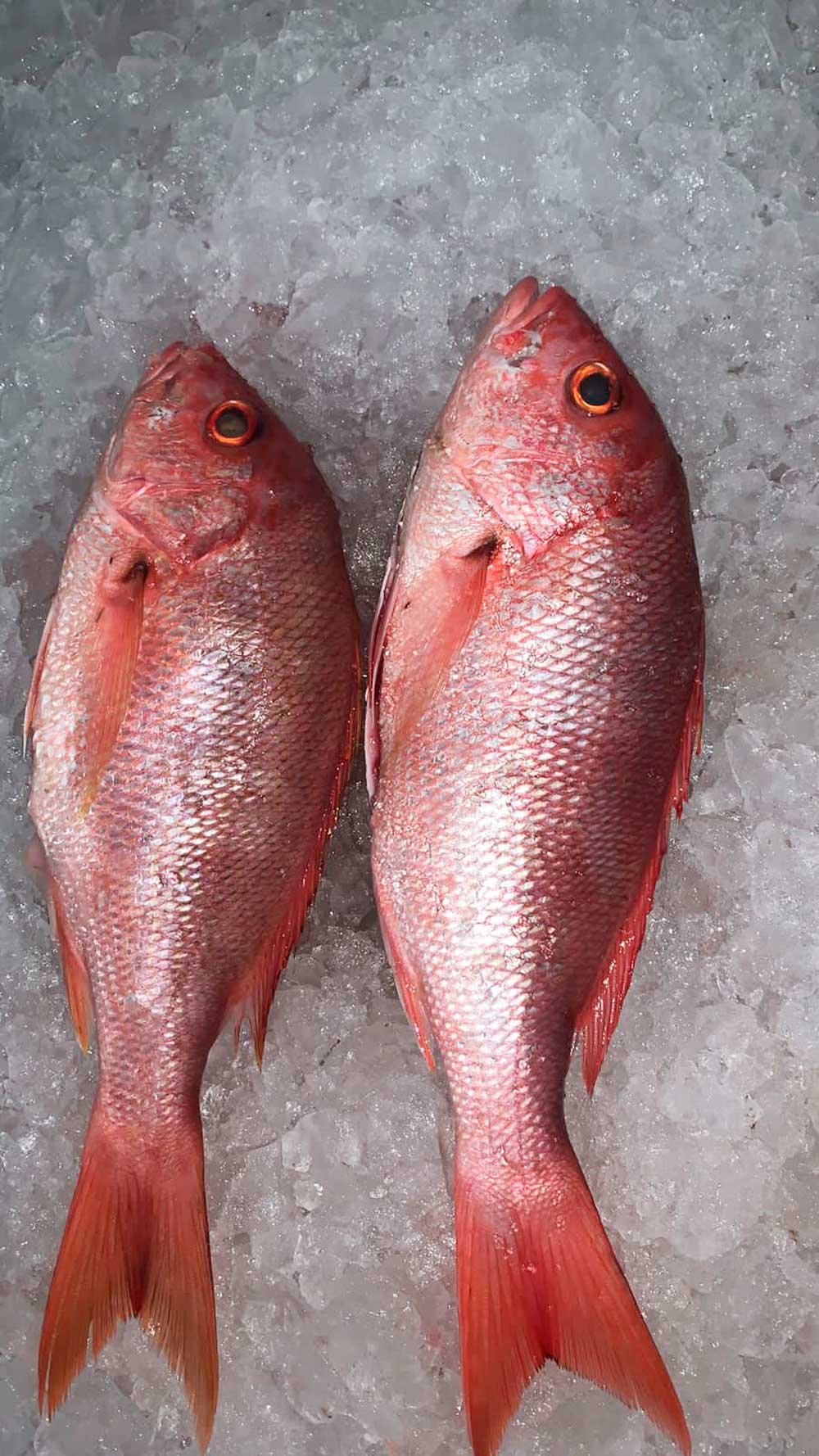
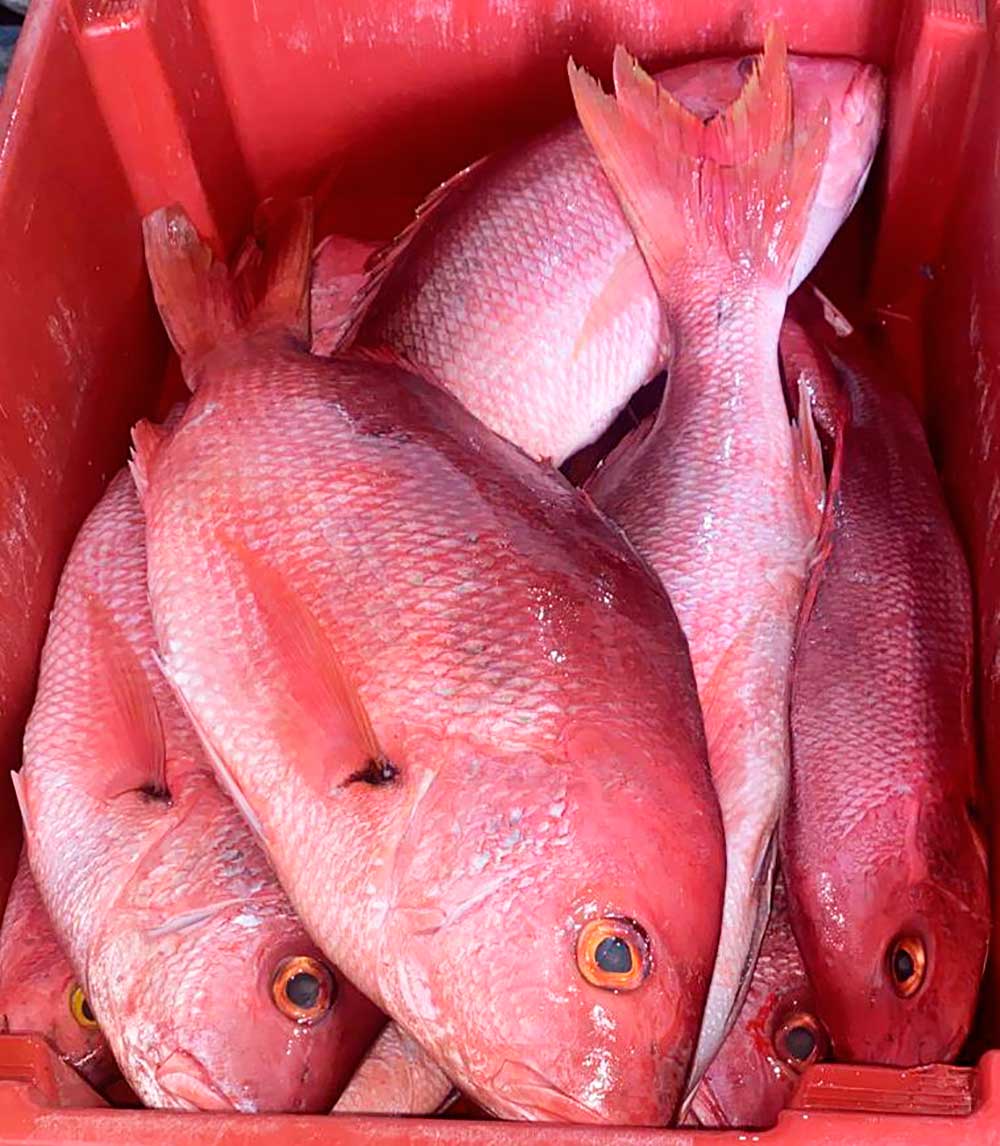
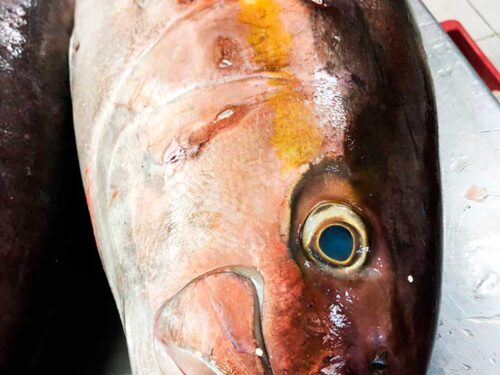
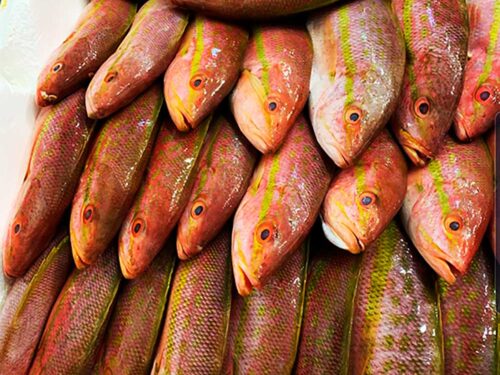
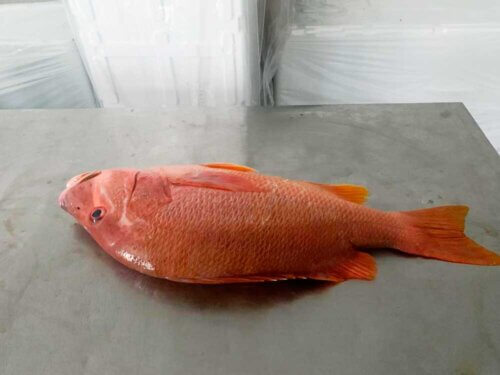

Reviews
There are no reviews yet.